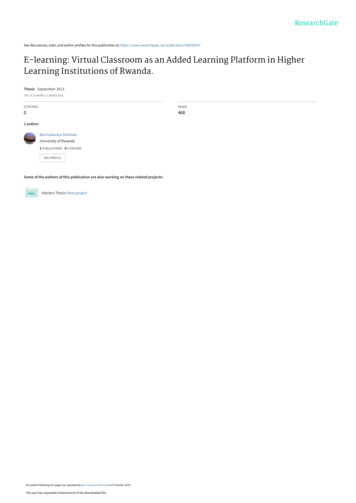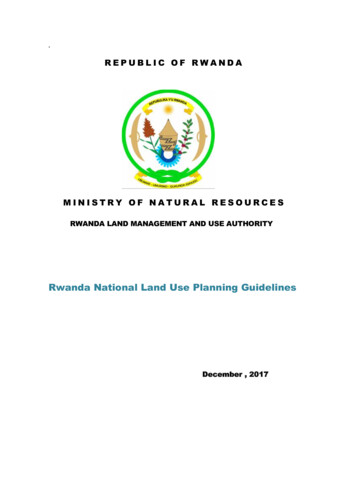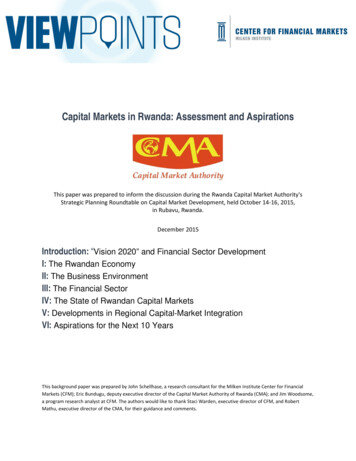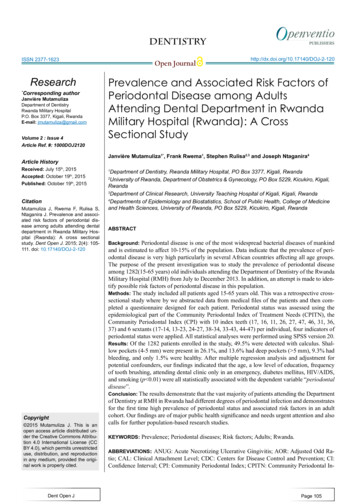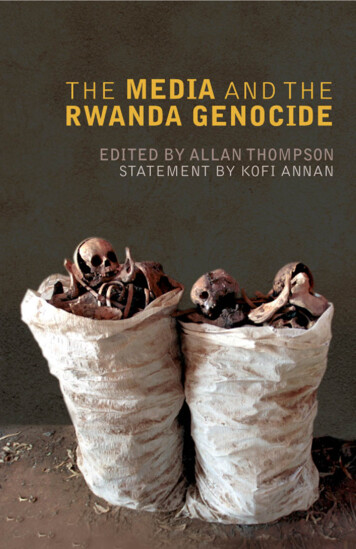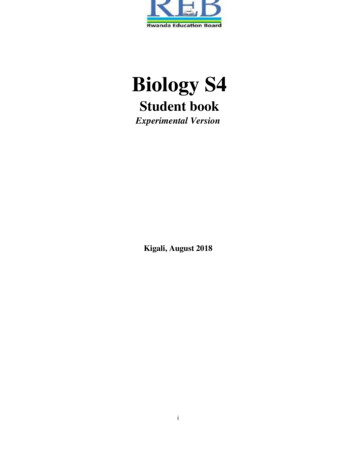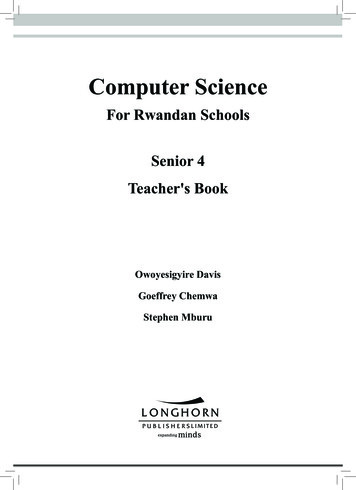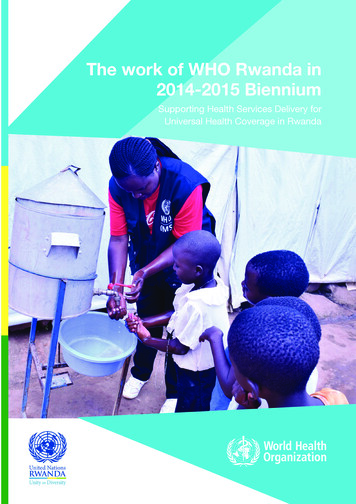
Transcription
The work of WHO Rwanda in2014-2015 BienniumSupporting Health Services Delivery forUniversal Health Coverage in RwandaWCO Rwanda Biennial Report 2014-20151
ForewordDr. Olushayo OluWHO RepresentativeIn the course of the 2014/15 biennium, the WHO Country Office (WCO)Rwanda experienced many positive developments that will shape its workin the coming years. A new generation Country Cooperation Strategy(CCS) covering the period 2014 to 2018 was finalized; this documentidentified key priority areas of the WCO for the next 3 years. The Officesupported the strengthening of policy dialogue, development, revision andevaluation of several health sector policy and strategic documents, andcapacity building of national health institutions. These contributed to keyachievements of the national health sector such as attainment of the healthrelated Millennium Development Goals (MDGs). However, the Office alsoexperienced several challenges including inadequate staffing, increasedworkload and underfunding of some programmes that constrained itswork.In spite of the challenges, WCO was able to achieve an implementationrate of more than 90 per cent of its 2014/15 biennial work plan. Theintroduction of new office management systems and technologies resultedin better communication, technical and operational capacity of the officeand new cost saving measures enhanced efficiency and facilitated costeffective programme management. The WHO Regional Office for AfricaTransformation Agenda provided a platform to strengthen and strategicallyre-position the office. Through encouragement of better communicationbetween the senior management, professional, and administrative staff, theworking environment in the Office improved tremendously with bettermotivation and increased productivity of staff members.In the 2016/17 biennium, our work will focus on supporting theGovernment of Rwanda (GoR) to implement Sustainable DevelopmentGoals (SDGs) and to achieve Universal Health Coverage (UHC) in thecountry. We shall do this by fostering national ownership and leadership,using an integrated and multi-sectoral approach, and building strategicpartnerships to enhance our technical capacity to support the government.The WHO Regional Office for Africa Transformation Agenda will also playa critical role in ensuring that the Office is a more responsive, action andresult oriented organization.We are counting on your usual collaboration, support and partnership aswe take on these challenges in the coming months.Thank youWCO Rwanda Biennial Report 2014-20152
AcknowledgementsThis report is a product of WHO Country Office for Rwanda. The activities reported were made possible with supportof several actors within and outside the organization. We would like to express our appreciation to the technical teamsat the Ministry of Health, Rwanda who diligently worked alongside the WHO teams to implement planned activities.We also thank members of the One UN Family and all our partners for the great collaboration accorded to WCORwanda. We also acknowledge the enormous support and contributions of our donors namely: Swiss Agency forDevelopment and Cooperation, the Embassy of the Kingdom of the Netherlands, the One UN Fund and the CERFSecretariat. Your support enabled the country office to implement our work as planned.To the WHO Inter-Country Support Team for East and Southern Africa IST/ESA, the Africa Regional Office (AFRO)under the able leadership of the Regional Director, Dr M. Moeti and WHO Headquarters in Geneva under the leadershipof Dr M. Chan, we say a big thank you.To everybody, we say thank you.WHO County Team RwandaWHO Country Team Rwanda credit: WHO RwandaWCO Rwanda Biennial Report 2014-20153
VCADHSDTPEACEKNEPIFICGPWGSRRS IIIGTCR VHibHIV/AIDSHMISHPVHQHRHHSSP nAfrica Regional OfficeAfrican Health ObservatoryAntenatal careAntiretroviral therapyCountry Coordinating MechanismsCountry Cooperation StrategyCentral Emergency Response FundCommunity Health WorkerInternational Centre for Tropical AgricultureCivil Registration and Vital StatisticsCore Voluntary Contributions AccountDemographic and Health SurveyDiphtheria, tetanus and pertussis (whooping cough)East African CommunityEmbassy of the Kingdom of the NetherlandsExpanded Programme on ImmunizationFully Immunized ChildrenGeneral Programme of WorkGlobal Status Report on Road Safety IIIThe Global Tobacco Control Survey VHaemophilus influenza type BHuman Immunodeficiency Virus/ Acquired Immune Deficiency SyndromeHealth Management Information SystemHuman papillomavirusHeadquartersHuman Resources for HealthThird Health Sector Strategic PlanInternational Atomic Energy AgencyInternational Agency for Research on CancerIMCI Computerized Adaptation and Training ToolIntegrated Disease Surveillance and ResponseIntegrated Management of Childhood IllnessInter-country Support Team/Eastern and Southern AfricaJoint Assessment of National Health StrategiesJoint Health Sector ReviewLong-Lasting Insecticide-treated NetsMonitoring and EvaluationMillennium Development GoalsMultidrug-resistant TuberculosisMinistry of Gender and Family PromotionMinistry of HealthMid-Term ReviewNon-Communicable DiseasesNational Health ObservatoryNational Institute of Statistics of RwandaNeglected Tropical DiseasesPublic Health Emergencies of International ConcernWCO Rwanda Biennial Report 2014-20154
COWHOWHO/AFROWISNDefinitionPrevention of mother-to-child transmission (PMTCT) of HIVPerformance of Routine Information System ManagementRegional Refugees Response PlanSwiss Agency for Development and CooperationSocial Determinants of HealthSupplementary Immunization ActivitiesSTEPwise approach to SurveillanceTuberculosisTerms of ReferenceUnited Nations Development Assistance PlanVoluntary Counselling and TestingWHO Country OfficeWorld Health OrganizationWHO Africa Regional OfficeWorkload Indicators of Staffing NeedsWCO Rwanda Biennial Report 2014-20155
Table of ContentsForewordAcknowledgementsAcronymsExecutive summary1. Introduction1.1 Background1.2 Health situation analysis1.3 WCO goals, objectives & expected outcomes for 2014-20152. Key achievements2.1 Health system strengthening2.2 Communicable & non-communicable diseases2.2.1 HIV/AIDS programme2.2.2 TB programme2.2.3 Malaria programme2.2.4 Expanded Programme on Immunization2.3 Prevention and control of communicable diseases2.4 Neglected tropical diseases2.5 Non-communicable diseases and nutrition2.6 Promoting health through the life course2.7 Disaster risk reduction, preparedness & response2.8 Partnerships2.9 Corporate services3. Conclusions3.1 Overall office performance3.2 Enabling factors3.3 Challenges3.4 Lessons learned3.5 Best practices and innovations4. Recommendations and action 1222223AnnexesWCO Directory, as of December 2015Technical support provided by IST/AFRO/HQList of meetings, conferences, trainings and workshops24242526Table of FiguresFigure 1 Evolution of the early childhood mortality rates in RwandaFigure 2 Child health in Rwanda (DHS 2015)Figure 3 Maternal health in Rwanda (DHS 2015)Figure 4 Evolution of the maternal mortality ratio in Rwanda991010WCO Rwanda Biennial Report 2014-20156
Executive summaryRwanda has made outstanding socioeconomic progress in the last two decades. Significant improvements in healthoutcomes and other key development indicators have been observed, especially in the area of maternal and child health.Despite the significant gains and improvements recorded, malnutrition remains a problem among children aged underfive years. Additionally, Rwanda is experiencing a significant increase in the number of malaria cases, from 514 173 casesin 2012 to 1 967 402 cases in 2015. The Ministry of Health and partners are currently tackling this challenge.This biennial report 2014/2015 outlines the work of the WCO Rwanda in cooperation with the Government of Rwanda(GoR) using five strategic priorities that guided the country office work. The strategies include:i)Support to health system strengthening,ii) Contribution towards reduction of morbidity and mortality associated with communicable and non communicable diseases,iii) Reduction of maternal, newborn and child morbidity and mortality;iv) Promotion of health by addressing the social determinants of health, health and environment, nutritionand food safety andv) Strengthening disaster risk management and epidemic emergency preparedness and response.During the reporting period, in collaboration with the Ministry of Health and other partners, the WHO Country Officecontributed to strengthening the health system by developing policies and strategic documents in the area of healthfinancing, health products and human resources for health. Comprehensive assessment of the health information systemwas also conducted, along with the implementation of a National Health Observatory and its components.In the area of communicable and non-communicable diseases, the development of policy, prevention and treatmentguidelines contributed to the increase in antiretroviral therapy coverage to 80 per cent; and reached a treatment successrate for confirmed TB cases of 89.8 per cent. MOH was supported to develop a five-year malaria contingency plan inresponse to the recent increasing incidence of malaria. The Expanded Programme on Immunization (EPI) achieved 97per cent vaccination coverage for all antigens, and maintained the country’s polio-free status, which was achieved in 1993.The programme supported the introduction of the Rotavirus vaccine which helped reduce rotavirus infections amongchildren as evidenced by the decrease in positivity rate from 50 to 19 per cent three years following the introductionof the vaccine in 2012. WHO also provided guidance to the MOH and its partners to develop and implement Ebolapreparedness activities. The revision of the National NTD Master Plan 2013-2018 and deworming of more than 95 percent of school-age children in all districts using Albendazole and Praziquantel were also conducted with the support ofWHO.Additionally, the WCO supported the MOH to review the algorithms for the management of severe acute malnutrition.Seven thousand (7,000) copies of comic booklets on proper nutrition were also distributed to school-age children andtheir families, along with 10,000 recipe books on complementary foods for infants and young children in the contextof prevention of stunting in under-five children. Multiple capacity building activities for health workers on nutritionwere conducted; and an operational research aiming at strengthening interventions to reduce malnutrition is also beingundertaken. A STEPS (STEPwise approach to Surveillance) survey to determine the prevalence of Non CommunicableDiseases (NCDs) and to determine their risk factors was conducted at the national level.To strengthen Maternal and Child Health, WHO provided technical support in the development of several documentsand tools especially in the domain of maternal, neonatal and child death audit, Integrated Management of ChildhoodIllness (IMCI) and postnatal care of the mother and new born.The social determinants of health, health and environment, nutrition and food safety were promoted through support tocreate the Water and Sanitation (WATSAN) Secretariat, the implementation of the Health Promotion Policy and StrategicPlan 2014-2018 and the review of the tobacco taxation policy. Capacity building for health care providers and communityWCO Rwanda Biennial Report 2014-20157
health workers was also provided to promote life through the life course. Official WHO Health Days, along with nationalcampaigns, were also commemorated with WHO support.WHO provided support for the development of the Regional Refugees Response Plan to address the emergency needsof Burundian refugees, specifically in the areas of: mobilization of funds for response, routine immunization campaigns,and recruitment of additional staff. In addition, the organization contributed to the management of an outbreak ofSalmonella typhi in the Mahama refugee camp during which a case-control study was conducted to identify risk factorscontributing to the spread of the disease.The organization played a leading role in implementing the health component of the United Nations DevelopmentAssistance Plan (UNDAP) in partnership with other UN agencies.Enabling factors such as good technical and financial support from different levels of the organization permitted the Officeto achieve most of its targets, and to reach a programme budget implementation rate of 94 per cent.Challenges such as increased incidence of malaria, decrease in external funds, and staff shortage resulted in a heavyportfolio, and impacted upon the work of the organization during the period in review.In the 2016/17 biennium, the Office will continue to support the country to sustain the achievements made so far,support will be provided to the Ministry of Health and other relevant sector Ministries to implement the SDGs,strengthen the health systems especially in the area of Universal Health Coverage, health financing and sustainabilityand information generation for decision making. All these will be implemented in line with the WHO Regional Office forAfrica Transformation Agenda.WCO Rwanda Biennial Report 2014-20158
Introduction1.1 BackgroundThis report outlines the work of the WCO from January 2014 to December 2015. WCO provides leadership on criticalhealth matters and partners with the Ministry of Health to achieve common goals.To that end, the main outputs, outcomesand impact of the WCO activities have been assessed against the 2014 to 2015 targets and expected outcomes thatwere collectively set and agreed upon by the Ministry of Health (MoH) and the WCO.This report summarizes the majorachievements, challenges, lessons learnt, and provides perspectives for 2016/17 biennium, in line with global, regional andnational commitments and orientations.1.2 Health situation analysisDuring the past twenty years, the Government of Rwanda has identified health as a top priority. This is reflected in thevarious policies developed1 by the country, as well by numerous progresses made towards the Millennium DevelopmentGoals (MDGs). According to the 2015 Demographic and Health Survey (DHS), from 2005 to 2015 the life expectancyat birth in Rwanda has increased from 51.2 to 65.7 years, above the MDG target of 58.The infant mortality rate also reduced from 86 to 32 per 1000 live births; while the under-five mortality rate droppedfrom 152 to 50 per 1000 live births. The successful scale-up of childhood health interventions such as increasedimmunization coverage and expansion of Integrated Management of Childhood Illness (IMCI) services at health facilityand community levels, contributed to this overall improvement. Ninety nine percent (99%) of children aged less thanone year are now immunized against measles in Rwanda (NISR, 2015), which is above the MDG target of 97 per cent.However, malnutrition remains a challenge in the country; although all measures of nutrition are improving, and 38 percent of under-five children are still stunted.Figure 1 Child health in Rwanda (DHS 2015)Figure 2 Evolution of the early childhood mortality rates in mlWCO Rwanda Biennial Report 2014-20159
Maternal health indicators also improved significantly with a decrease in the maternal mortality ratio from 750 to 210 per100,000 live births in the last ten years. This is due to the: (i) scale up of maternal health interventions such as the use ofmodern contraceptive methods among married women that increased from 17 to 47 per cent; (ii) increased number ofdeliveries at health facilities from 39 to 91 per cent; and (iii) increased number of pregnant women attending four (4 )antenatal care sessions (from 13 to 44 per cent).Figure 3 Evolution of the maternal mortality ratio in RwandaFigure 4 Maternal health in Rwanda (DHS 2015)Malaria, which has been steadily increasing since 2012, is another challenge that is being tackled by the Ministry of Healthand its partners. A significant drop in the coverage of effective long-lasting insecticide-treated nets (LLINs), resistance toinsecticides, and climate change partially explain this phenomenon.Socio-political tensions that started rising in Burundi in April 2015 ahead of the general election, resulted in thousandsof Burundians fleeing their country and seeking refuge in neighboring countries including Rwanda. On 22 April 2015,the Government of Rwand a set up a refugee camp in Mahama sector, Kirehe District, in Eastern Province to receiveBurundian asylum seekers. As of December 2015, a total of 45 460 Burundian refugees grouped in 17 783 householdswere located in Mahama camp. WCO is providing leadership to the ongoing health response and together with otherpartners, have established a disease surveillance system, and conducted an assessment of malaria and the Water, Sanitationand Hygiene (WASH) situation in the camp.This close collaboration resulted in the control of the typhoid fever outbreak.1.3 WCO goals, objectives & expected outcomes for 2014-2015The goals, objectives and expected outcomes of WCO Rwanda are articulated in the Rwanda Country CooperationStrategy (CCS)’s for 2014-18. These are to:1.2.3.4.5.Support health system strengthening towards health service integration and universal health coverage;Contribute to the reduction of morbidity and mortality associated with communicable and non-communicablediseases, consolidation of health-related MDGs gains and planning to facilitate the achievement of the post 2015development goals;Contribute to the reduction of maternal, newborn and child morbidity and mortality;Promote health by addressing the social determinants of health, health and environment, nutrition and food safety;Strengthen disaster risk management and epidemic emergency preparedness and response; and implementation ofthe International Health Regulations.The key achievements highlighted below are therefore presented according to the above priorities.WCO Rwanda Biennial Report 2014-201510
2. Key achievements2.1 Health system strengtheningDuring this biennium, the office provided technical and financial support to the MOH to develop and validate severalpolicies and strategies in a bid to strengthen the national health system.Support provided in the Health Financing area resulted in the development of the national Health Financing Policy andthe Health Financing Strategic Plan that facilitated the restructuring of the Community Based Health Insurance (CBHI).Its movement from MOH to the management of Rwanda Social Security Board resulted in the improvement andstrengthening of CBHI management, reduction of transaction costs, better services to clients and increase in servicecoverage. Support was also provided for the development of the: (i) National Health Sector Policy; (ii) Human Resourcesfor Health Policy (HRH); (iii) HRH Sustainability Plan 2014-2024, and (iv) HSSP III monitoring and evaluation (M&E)plan 2014-2018. Rwanda WCO also coordinated the Mid-Term-Review of HSSP III that provided clear guidance andrecommendations for better implementation of interventions in the remaining period of the strategy.Handover of donated albendazole and praziquantel to the Rwanda Ministry of Health Neglected tropical diseases teamWCO Rwanda Biennial Report 2014-201511
In the area of Health products and technologies, the WCO provided technical support to the review of: (i) NationalPharmaceutical Policy, (ii) the sixth edition of National List of Essential Medicines for adults, (iii) first edition for childrenthat now includes medicines for palliative care and cancer, and (iv) development of the Traditional medicine policy andlaw regulating the practice of traditional medicine. In addition, the office supported the development of the medicallaboratory equipment harmonization policy document, which helped to strengthen the laboratory network capacity indefining standards related to infrastructure, equipment, personnel, testing, quality assurance, biosafety and biosecuritysystems. The District Pharmacy Supply Chain Operations Manual was also elaborated to contribute to the effectivenessof the pharmaceutical supply chain.The National Policy for Access to Quality Health Care Services was also developed to improve patient safety and qualityof services.In the Health Information domain, the office advocated for, and successfully supported the completion of the RwandaAnalytical Profile and establishment of the Rwanda National Health Observatory (NHO) prototype, which will serveas a platform to share quality assured health information of the country. An evaluation of the Performance of RoutineInformation System Management (PRISM) assessment was also supported; along with the development of a researchM&E framework for the implementation of the National Health Research Agenda to coordinate research activities. InDecember 2015, WHO supported the MOH to train more than 10 persons from Rwanda Biomedical Center (RBC),the National Institute of Statistics (NISR) and the School of Public Health on the National Health Observatory (NHO).At the end of the training, participants developed a draft roadmap for the implementation of the NHO. The organizationalso initiated discussion with the NISR for collaboration on Civil Registration and Vital Statistics (CRVS) as a tool for futuremortality estimates in the country.2.2 Communicable & non-communicable diseases2.2.1 HIV/AIDS programmeDuring the period in review, WHO supported MOH/RBC to revise the national HIV treatment guidelines that adoptedthe “treat all” policy and HIV self-testing, the development of the viral hepatitis policy, prevention and treatment guidelinesand operational plan. The policy change is expected to result in an increase in the number of PLWHIV, as more peoplewill know their HIV status, and a matched increase of ART coverage from 80 to 90 per cent. In this regard, Rwanda willbe among the first countries in Africa to achieve the 90-90-90 target launched by UNAIDS and WHO in 2014.In addition Direct Acting Antiviral (DDA) for treatment of HCV infection, Tenofovir and Entecavir for treatment ofHepatitis B Virus (HBV) infection were added to the list of essential drugs. During the period under review, 478 patientswith HCV chronic infection initiated treatment with DAA at four referral hospitals. The HIV/TB joint concept notedrafted with the support of WHO received funding from GFATM and the PEPFAR country operating planning (COP2014 and 2015). The funding enabled the country to expand HIV services and to improve PMTCT coverage currentlyat 96 per cent, ART coverage at 80 per cent and the provision of voluntary male medical circumcision (VMMC) servicesto 162 074 clients.2.2.2 TB programmeWHO supported the country to develop the TB National Strategic Plan (NSP) for 2013-2018 and the joint assessment(JANS) of TB NSP. The TB programme strategy and funding mobilized enabled the expansion of TB testing and treatmentservices. This resulted in the treatment success rate for 89.8 per cent of TB cases registered in the 2013-2014 fiscal year.2.2.3 Malaria programmeWHO contributed to the development of Malaria National Strategic Plan 2013-2018 and its joint assessment (JANS).The office coordinated the development of a malaria concept note that was funded by GFATM and contributed to theWCO Rwanda Biennial Report 2014-201512
provision of malaria preventive and curative services at both health facility and community levels. We should highlight thatdespite these achievements Rwanda is experiencing a significant increase of malaria cases, from 514 173 cases in 2012 to1 967 402 cases in 2015. To address this situation, WHO in collaboration with other partners is supporting the Ministryof Health to implement the malaria contingency plan that covers a period of five years.2.2.4 Expanded Programme on ImmunizationThe National Expanded Programme of Immunization of the Ministry of Health received support from WHO incollaboration with other partners to implement the following activities:The Reach Every Child (REC) Strategy aims at improving immunization coverage among children aged one year andbelow. During the period under review, one of the interventions supported was training of supervisors from all districthospitals (84), health centres (480) including supervisors of community health workers at all benefitting health centreson this project. As a result, 335 850 children under one year were vaccinated, representing a coverage of 97 per cent.The development of a grant proposal submitted to GAVI that aimed at introducing a new vaccine in the routineimmunization programme was also supported, which resulted in the introduction of the Rubella vaccine in 2014,increasing the number of vaccines in the Routine Immunization programme to 12.ONE UN handing over HIV guidelines to the Ministry of HealthThe office also supported the establishment of an active surveillance system that monitors vaccine preventable diseaseson a weekly basis. In this context, the surveillance of Acute Flaccid Paralysis (AFP) was strengthened through refreshertraining of all districts hospital managers. The measles elimination mode was also introduced in order to meet measleselimination standard.The first ever combined comprehensive Expanded Programme of Immunization (EPI) and in-depth surveillance reviewthat incorporates post introduction evaluation of a new vaccine (Measles-Rubella) was also conducted with WHO. Thereview showed that the immunization system in Rwanda is well established, with high-level government commitment andownership, and a strong and effective collaboration of EPI partners.WCO Rwanda Biennial Report 2014-201513
WHO supported vaccination of children through various national immunisation campaigns credit: WHO RwandaAdditionally, a study on rotavirus vaccine impact and effectiveness was supported from 2012 to 2015. The findingsshowed that three years after the introduction of rotavirus vaccine, the rotavirus positivity rate among children enrolledin the study was 19 per cent compared with 49.8 per cent before its introduction. The under-five hospital admissions forall causes have also decreased with time as well as gastroenteritis case admissions. (This is usually indicative of rotavirusinfections among under fives).Rwanda also maintained its status of being free of circulating poliovirus, as well as elimination of neonatal tetanus andmeasles.2.3 Prevention and control of communicable diseasesWHO supported MOH/RBC to conduct a yellow fever risk assessment, which showed that Rwanda is at low risk ofyellow fever transmission and provided recommendations to strengthen the yellow fever case-based surveillance. Thedevelopment of the One Health plan that addresses surveillance and response to epidemic prone diseases was alsosupported. Furthermore, WHO provided guidance to the MOH and its partners to develop and implement Ebolapreparedness activities. A preparedness and response plan was developed and implemented, and sensitization sessionswere conducted for UN Agencies, Bilateral and Multilateral Cooperation Agencies (IMF, World Bank, BTC and JICA),Embassies (Belgium, British and Japan) and in all populations in refugee camps.2.4 Neglected tropical diseasesDuring the reporting period, WHO supported MOH/RBC to revise the National Neglected Tropical Diseases (NTDs)Master Plan 2013-2018. The plan is currently being used to guide the prevention, control and elimination of neglectedtropical diseases in line with the WHO 2020 targets. During the same period, Rwanda was removed from the list ofendemic countries for Lymphatic Filariasis. The office also provided over 1.3 million Mebendazole (Vermox, 500 mgtablets) and 747 000 Praziquantel (600 mg) tablets to the Ministry of Health for the control of neglected tropical diseases.In addition, it donated Albendazole to all districts and Praziquantel to six districts for campaigns targeting preschooland school age children; as a result, more than 95 per cent of children in the target group were dewormed though thecampaign.WCO Rwanda Biennial Report 2014-201514
WHO staff deworming a school age child during the launch of a national campaign Rwanda credit: WHO Rwanda2.5 Non-communicable diseases and nutritionThe office assisted different government institutions including the Ministry of Health to develop a national protocol onnutritional care for the prevention and management of non-communicable diseases, and the review of algorithms forthe management of severe acute malnutrition, which has been included in the national protocol on management ofmalnutrition.The Ministry of Health and the Rwanda Bureau of Standards received support to develop a national standard on“Formulated complementary foods for older infants and young children” based on the Codex Alimentarius standards.This was complemented by support to the Ministry of Education and the Ministry of Health to design and produce acomic booklet on nutrition targeting school-age children aiming at disseminating information to children and their families.Seven thousand (7,000) copies of those books were distributed to schools in Rutsiro and Nyamagabe districts by theMinistry of Education to increase awareness on prevention of malnutrition in children. In addition, the office supporteddevelopment and dissemination of 10 000 recipe books on complementary foods to prevent stunting in children underage five.An operational research at district level aimed at strengthening interventions to reduce malnutrition in countr
in 2012 to 1 967 402 cases in 2015. The Ministry of Health and partners are currently tackling this challenge. This biennial report 2014/2015 outlines the work of the WCO Rwanda in cooperation with the Government of Rwanda (GoR) using five strategic priorities that guided the country office work. The strategies include:


